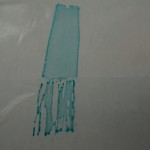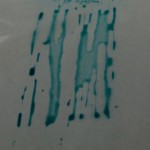We’ve all had it happen. We find a roll in inventory, perfect for that rush job, only to find that there is no identification on the roll. How to determine the functional side? Here are some quick tips to get you out of that jam and producing product in confidence.
First a quick how to:
- Ensure the film surface is clean and clear of any contaminates. It is recommended to remove at least one full wrap from the outside of the roll before taking your test sample.
- Fold the sample so as to have both sides of the film upper-most
- Draw the dyne pen across the web so to test both sides of the film
- Evaluate the results
- Separate sets of pens should be kept for different substrate types
Dyne solution pens will quickly and effectively identify the treated surface of many film types. Below show results with dyne solution applied to a treated and non-treated surface of polyester.
Polyester:
The non-treated side of polyester has a natural dyne level of 44 so you will need to use a high dyne treat pen (58 dyne solution pen is recommended) to determine the treated side. The dyne solution will bead-up immediately on the untreated PET side, while it will wet-out (remain flat) on the treated surface.
Polypropylene and polyethylene films:
Polypropylene, with a natural (untreated) dyne level of < 34, won’t require quite so high a dyne pen. 44 – 48 dyne level will work well to confirm the treated side. This same range of dyne pen will be suitable for polyethylene as well. As with the polyester the dyne solution will bead-up immediately on the untreated film side, while it will wet-out on the treated surface.
Silicon Oxide (SiOx) or Aluminum Oxide (AlOx) Coated films:
Dyne solution pens will also work well with SiOx or AlOx coated films to tell very easily which side has the coating. As in the above examples, the dyne solution beads up immediately on the untreated PET side, while it wets-out well on the SiOx or AlOx side. Both AlOx and SiOx coatings have a surface energy >60 dynes/cm.
Water will work in the same way for these oxide coated films and is necessary if you don’t have a 60 + dyne pen available when the non-coated side is treated as well. The water applied across the sample will bead-up on the polyester side but will remain as a continuous film on the coated surface.
Another check that can be performed on these coated films is to notice which way the film curls, as it will tend to curl away from the coated side.
PVdC Coated films
Testing for PVdC requires use a solution of potassium hydroxide, tetrahydrafuran and dimethyl sulfoxide. This can be made in a well-equipped lab or sourced through ink suppliers. When the solution is applied to a PVdC coating, the film will turn black.
PVC Coated films
With the same solution as sited above one can also test for PVC coatings. When the solution is applied to PVC coating the film will turn a brown/red.
PVOH Coated films
To determine presence of PVOH a solution of potassium iodide and iodine is required. When applied to PVOH the PVOH coating will change to a very dark brown.
|
Treat Identification |
||||
|
Film Type |
Dyne solution remains as a continuous film on the treated or coated surface | Water remains as a continuous film on the coated surface | Film curls away from the coated side |
Chemical Test Results |
|
Polyester |
x |
|||
|
Polypropylene |
x |
|||
|
Polyethylene |
x |
|||
|
PVdC Coated Films |
Film turns black in 30 – 60 seconds when PVdC coating is present | |||
|
PVC Coated Films |
Film turns very dark brown in 30 – 60 seconds when PVC coating is present | |||
|
PVOH Coated Films |
Film turns brown/red in 30 – 60 seconds when PVOH present | |||
|
SiOx Coated PET |
x |
x |
x |
|
|
AlOx Coated PET |
x |
x |
x |
|
Happy testing – or rather producing!
-Naomi
Naomi Panagapka
Customer Solutions
Celplast Metallized Products
Providing the industry’s best customer service






Dyne level on the metallized side of a 48 ga PET can range from 60 – 70 dyne/cm as the aluminum has a natural dyne level.